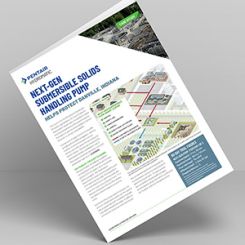Learn what to expect from centrifugal, reciprocating and rotary pumps.
Hydraulic Institute
04/06/2018
To understand how the viscosity of a liquid affects a pumping system, it is important to understand what viscosity represents. By definition, viscosity is the property of a liquid that causes it to offer resistance to shear stress such as that caused by liquid flow, primarily in the area of the pipe wall.
 Image 1. Absolute viscosity illustration of velocity gradient from the moving surface (liquid) to the static surface (pipe wall) (Images courtesy of Hydraulic Institute)
Image 1. Absolute viscosity illustration of velocity gradient from the moving surface (liquid) to the static surface (pipe wall) (Images courtesy of Hydraulic Institute) Image 2. Example of SSU viscosity measurement)
Image 2. Example of SSU viscosity measurement) Image 3. Centrifugal volute pump
Image 3. Centrifugal volute pumpPump Types
Depending on the pump type, the impact of liquid viscosity is different. We will look at three types of pumps specifically: centrifugal (Image 3), reciprocating (Image 4) and rotary (Image 5). Reciprocating and rotary pumps are within the positive displacement (PD) family. PD pumps displace a certain volume with every revolution of the shaft, minus any volumetric leakage (slip). Image 4. Reciprocating (piston) pump
Image 4. Reciprocating (piston) pump Image 5. Rotary (screw) pump
Image 5. Rotary (screw) pumpCentrifugal Pump Viscous Pumping Considerations
It is industry standard to test the performance of centrifugal pumps with clear water per ANSI/HI 14.6 Rotodynamic pumps for Hydraulic Performance Tests. The performance of a centrifugal pump is affected when handling viscous liquids because of the increased friction when the impeller rotates and the resistance to flow compared to water test. A marked increase in input power due to reduced efficiency and a reduction in head and rate of flow occurs with viscous liquids compared to water. The performance curve in Image 6 shows the water performance and the corrected viscous performance for the application liquid, which has a viscosity of 1,000 SSU and specific gravity of 0.9. The viscous data should be corrected from the water performance test per Hydraulic Institute standard ANSI/HI 9.6.7 Effects of Liquid Viscosity on Rotodynamic Pump Performance. ANSI/HI 9.6.7 was used to correct the performance as shown in Image 6. This standard prescribes an empirical method based on test data available from sources throughout the world. Image 6. Centrifugal pump “water” performance and corrected viscous performance
Image 6. Centrifugal pump “water” performance and corrected viscous performancePD Pump Viscous Pumping Considerations
PD pumps are inherently different than centrifugal pumps because they move a volume of liquid by displacement for every revolution of the shaft. This generally provides favorable results when pumping viscous liquids. The volumetric efficiency of a PD pump is the actual volume per shaft revolution over the theoretical volume per shaft revolution. The difference between the two volumes is the result of leakage flow that is known as slip. The higher viscosity of a liquid actually reduces the amount of slip and increases the volumetric efficiency of a positive displacement pump. Image 7. General capacity for PD pump as a function of speed and viscosity
Image 7. General capacity for PD pump as a function of speed and viscosity Image 8. Viscous input power
Image 8. Viscous input power Image 9. Viscous NPIPR
Image 9. Viscous NPIPR
